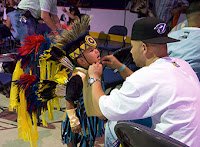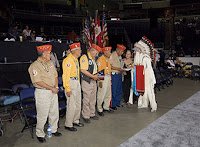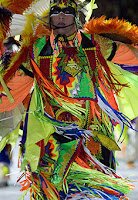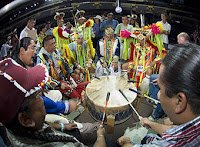 The National Powwow was recently held in Washington D.C. at the Verizon Center arena from August 10th through August 12th. The images from this fantastic yearly event are rich with the culture I try to teach my students. The facts and images I share here are mainly from the National Museum of the American Indian and from an online article at the USINFO website.
The National Powwow was recently held in Washington D.C. at the Verizon Center arena from August 10th through August 12th. The images from this fantastic yearly event are rich with the culture I try to teach my students. The facts and images I share here are mainly from the National Museum of the American Indian and from an online article at the USINFO website.
1. The word “powwow” comes from a Narragansett word pauwau, which referred to curing ceremonies in times long past. Once the English language reached North America the word came to be known as an Indian gathering or as a verb meaning “to confer in council”. In Indian Country, it came to mean a “secular event featuring a group singing and social dancing by men, women, and children.”
2. During the powwow, Native people pay homage to past, present, and future generations of Native Americans from all tribes through music, dance, giveaways, namings, and other  ceremonies. In the past a single community would have their own celebrations and would not include other tribes. The National Powwow includes many tribes and creates a physical and spiritual circle where they are all free to share traditions, languages, songs, dances, foods, jokes, and blessings.
ceremonies. In the past a single community would have their own celebrations and would not include other tribes. The National Powwow includes many tribes and creates a physical and spiritual circle where they are all free to share traditions, languages, songs, dances, foods, jokes, and blessings.
3. The most important thing to remember about the National Powwow is it symbolizes cultural survival and perseverance to celebrate and maintain Native identity into the 21st century.
4. The earliest powwow that was intertribal was the Ponca Powwow, which began in 1879 in Indian Territory, according to Dennis Zotigh (Kiowa), the NMAI National Powwow cultural advisor. “Indian Territory was truly intertribal,” Zotigh says. “Sixty-seven tribes were removed from their original homelands and placed in what was to become the state of Oklahoma. At the Ponca Powwow, many tribal members traveled more than 100 miles to participate in the intertribal singing and dancing.”
5. Many of the activities performed at the National Powwow have their origins at the ceremonial war dances of the Great Plains. The basis of the Powwow is taken from ceremonies performed by the Osage, Ponca, Kaw, Omaha, and Pawnee tribes. Many of the head staff positions in the powwow arena stem from ceremonial offices held by warriors. A powwow’s head singer, emcee, arena director, and head man dancer, for instance, are direct descendants of official positions in the Inlonshka and other ceremonies.
6. Several formal and religious observances take place during the Grand Entry that marks the beginning of the afternoon and evening sessions. You can see a list of Powwow events here. The Flag Song is the Native equivalent to the National Anthem, and is dedicated to the men and wom en who have served in the armed forces.
en who have served in the armed forces.
7. Attendees should never refer to “costumes” when speaking of Native dress. This is derogatory to many and implies garishness. It is acceptable to use the words “regalia” or “outfits”. A dancers outfit should never be touched without permission, though they are tempting. Many items—eagle feathers, dance sheilds, and clothing—hold personal, historic, and religious significance, and are cared for in a sacred manner.
8. Photography is allowed during a Powwow, but you should always ask for permission before simply snapping away. However, certain events prohibit photography, audio, and video recording such as prayers, Honor Songs, and Memorial Songs. If you attend a Powwow the emcee will always announce those parts of the program. What happens if an eagle feather is dropped in the area? A Pick-up Dance will be performed, in which one or more veterans are  selected to pick up the fallen feather. An Eagle Bone Whistle Song and a special prayer are offered. No pictures would be taken during this time.
selected to pick up the fallen feather. An Eagle Bone Whistle Song and a special prayer are offered. No pictures would be taken during this time.
9. The front seats are always reserved for dancers and elders. Blankets and shawls are usually placed over them to reserve them. Never walk through the area.
10. Always move around the perimeter. Do not crowd the drum. Please allow sufficient space for drum judges, singers, and family members. Powwow organizers never allow any smoking, drinking, or drugs on the premises.
11. Rituals and dances associated with warrior honor societies are still performed, however today they honor American Indians soldiers serving in the U.S. Armed Forces, as well as legendary warriors from the past. As in all other American Indian dances, performers must pay close attention to the drums because they are required to conclude the dance exactly on the last beat.
12. Many of the dances performed at the Powwow are faithful to early dances, but many have been modernized. The Green Dance was performed across America’s Great Plains during the late 1800s before declining in popularity. Recently it has become more popular. It is performed by male dancers with yarn fringes that represent prarie grass and is thought to be part of a c omplex healing ceremony.
omplex healing ceremony.
13. So, why do members of the participating tribes go to so much trouble. In this article two tribal members said, “I want to show people that there’s more to us than what they have seen in the movies,” said Wylie Bearstail (Hidatsa/Arikara), a grass dancer. Rylan Baker (Hidatsa/Cree), who specializes in the Men’s Fancy Dance, agreed: “I hope that [spectators] will get a different perspective on Native Americans. We’re not savages; we’re just like anyone else.”



